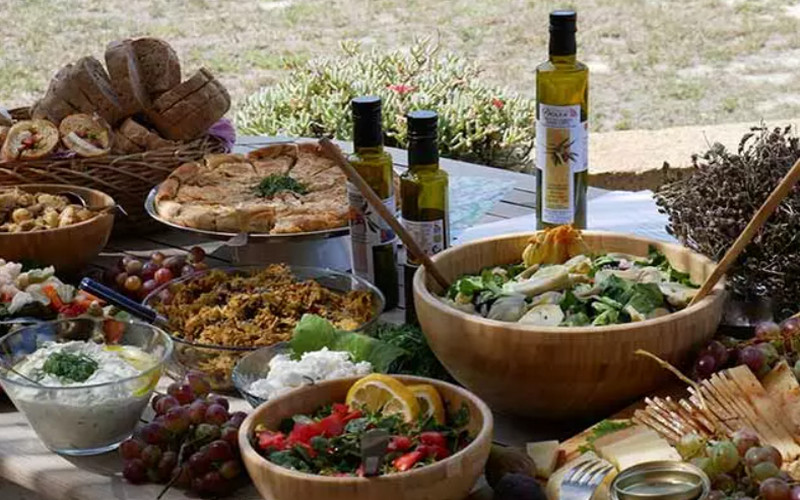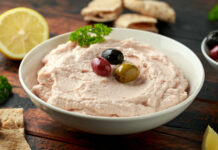The ancient Greeks thought of cooking as both a science and an art- so much that it could even be a topic for philosophy. In out of the way places on the mainland and on the more remote islands, you will still find dishes, ingredients and culinary styles untouched by time. In other regions, Greek cuisine has been much influenced by the Ottoman empire which includes spiced meat dishes and filled pastries and vegetables. In the recent past, Greek cuisine was often regarded as peasant food. Today, it is because of that simplicity and the use of seasonal, local produce, what makes Greek food so popular with visitors.
ATHENS AND THE PELOPONNESE
The capital in its essence is a city of immigrants who came from the countryside, the islands and the shores of the Eastern Mediterranean. That diversity can be seen in its markets and its cuisine. Street food is an essential part of Athens life. In the Peloponnese, the ingredients are as varied as the terrain: fish from the sea and from the mountains, sheep, goat and game.
CENTRAL AND NORTHERN GREECE
Mainland Greece with its long and turbulent history, is a place where regional food boundaries are blurred and a variety of different cooking traditions coexist. The meat and fruit dishes of Thessaloniki show a Jewish influence; the spices, sausages and oven cooking of Ioannina stem from Ottoman times, while a love of sheep’s cheese, pies and intestines came to Metsovo and the Epirus mountains, the area of Vlach shepherds. The spicy food of the North is the legacy of the 1922 Greek immigrants from Asia Minor, while the Balkan influence is obvious in the use of pickles, walnuts and yoghurt.

THE ISLANDS
Each group of islands has its distinctive culinary identity which depends on geographical location and history. Many Ionian dishes are based on pasta, a legacy of the time of the Venetian occupation. Those of the Cyclades are intensely flavoured. The cooks of the Dodecanese and Northeast Aegean islands rely on the rich harvest of the surrounding sea. Crete is unique in its long Turkish occupation and taste for high spiced dishes. Cretan cooking has a number of recipes that are very typical to the island. The use of pork is more dominant here than anywhere else in Greece. Some lovely kitchen utensils and unusual ingredients from Minoan times have been excavated by archaeologists on Crete.
FISH AND SEAFOOD
The warm and sheltered waters of the Aegean are the migratory path for tuna and swordfish and rich in tasty anchovies and sardines. Coves and caves around the hundreds of islands in the Aegean sea shelter a very popular red mullet, dentex and parrot fish, while the long shoreline is rich in shellfish and crustaceans. Fish is usually served with its heads still on: to Greeks, this is the tastiest part and it also helps to identify the variety.

OTHER PRODUCE
Mainland Greece and its islands are home to the largest variety of olives in the world. They are cured by methods that have been in use for thousands of years. The best quality olive oil is extra virgin. It is made by pressing just- ripe olives. Greece produces sheep’s, cow’s and goat’s cheeses, usually named by taste and texture, not by origin.
WHAT TO DRINK
Wine has been part of Greek cultural life since the earliest times. Major wine producing areas include Attica, Macedonia and the Peloponnese.Mavrodaphne is a fortified dessert wine from Patra. Greek specialties include tsipouro, distilled from the residue of crushed grapes; retsina, a wine flavoured with pine resin and the strong, aniseed- flavoured spirit, ouzo. Coffee in Greece is traditionally made from very finely ground beans boiled up with water in a long handled coffee pot and drunk from a tiny cup. It is served in cafes rather than taverns.
REGIONAL DISHES AND SPECIALTIES
Sweets such as nougat, pasteli (honey- sesame candy), loukoumia (yeast doughnuts in syrup) and chalvas (halva or sweetmeats) have been a part of Greek street life since the days of Aristotle. They are sold in small shops and stalls. Pittes, or pies, are a specialty of the western Epirus region. Fillings range from game or offal to cheese and vegetables, often combined with rice and pasta.

Reflecting Middle- Eastern influences, Soutzoukakia, a specialty of northern Thrace and Macedonia, are meat patties flavoured with coriander, pepper and cumin.
Choirino kritiko, is the classic dish of inland Crete villages. It’s thick pork cutlets baked until tender.
Syka me tyri is a summer mezes, can be dessert or snack, consisting of fresh figs with mizthyra cheese, made from whey.
Fakes is a sour Peloponnese soup made of green lentils, lemon juice or wine vinegar with added tomatoes, herbs and olive oil.
Spetzofai, from central Greece, is sauteed slices of spicey country sausage with herbs and vegetables.
Barbounia, or red mullet, has always been a highly prized fish in Greece. It is usually simply fried.
Loukoumades are a snack of small deep- fried doughnuts soaked in honey- syrup and sprinkled with cinnamon.





